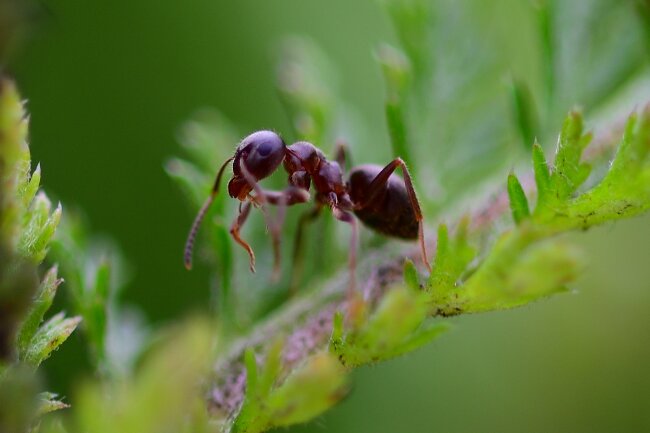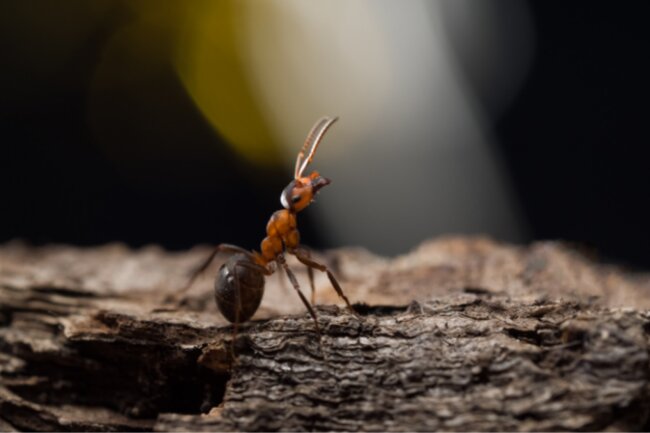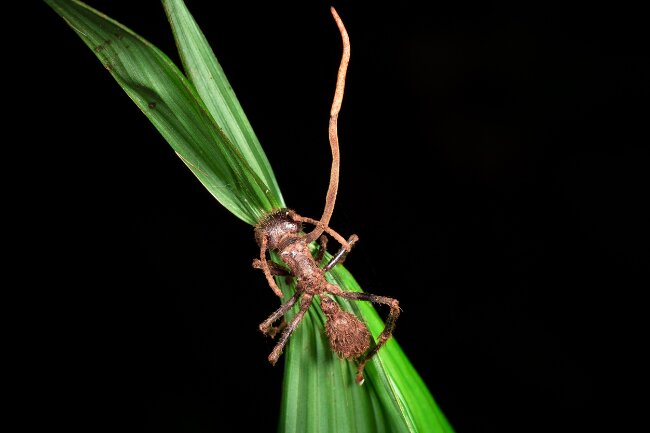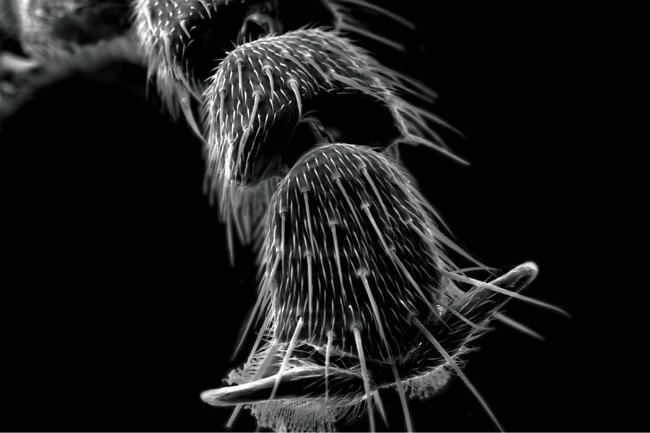Ants have six legs, which are located on their thorax. They use their legs in a variety of ways, such as to create bridges, run and communicate.
Contents
How many legs do ants have?

Ants are a type of insect, which means like all insects they have six legs, in three pairs. These legs are attached to the second major body section, the thorax, which comes after the head and before the abdomen.
The legs are made up of several sections, the tarsus, the tibia and the femur. These many joints allow the ants to have very good movability in their legs. Ants are said to have an alternating tripod gait, which means that the front and back legs on one side move with the middle leg on the other side, and then the opposite occurs.
The majority of ant species start life as an egg, which is laid by the queen of the nest. The egg will then hatch out into a larva, which is a grub-like creature without any legs. The larvae’s job is to eat, and the workers feed it regularly until it is ready to pupate.
Like caterpillars, ant larvae go through a metamorphosis. Some species spin silken cocoons around themselves, while others do not. It is during this pupation that they develop their legs, which allow them to move around as an adult.
Also read: Here’s “How Ants Become Queens” – FAQ
Why do ants have legs?
| Leg Segment | Function |
|---|---|
| Coxa | Connects the leg to the ant’s body |
| Trochanter | Articulation point for leg movement |
| Femur | Provides stability and strength to the leg |
| Tibia | Supports the leg and aids in walking |
| Tarsus | Contains sensory structures like hairs and chemoreceptors |
| Pretarsus | Bears adhesive pads or claws for gripping surfaces |
Walking and running
The most obvious reason for ants to have legs is of course to get around. Ants spend a great deal of time searching for food or moving around inside the nest. While the fertile young queens and males in most species have wings to help them disperse, the majority of ants are workers and do not have wings.
Climbing walls
Ants can use structures on their legs to help them climb even vertical walls.

Touching
For most ants the most important appendages for sensing objects and creatures before them are their antennae, however, some species will also use their front legs to touch and feel.
Building structures
Many ant species have an amazing ability to build large and complex structures just using their bodies. This can be bridges, floating rafts, or even towers. In order to hold onto each other, and the surfaces around them, they will use their legs and mandibles. These structures help ants overcome obstacles as a group that would defeat them as individuals.
Grooming
Most ants used their legs are part of their grooming routine, to remove dirt and food from their bodies. This helps to avoid the spread of disease. The antennae, as the main sense organs, are particularly important to keep clean. To this end, some ants have tiny brushes on their legs, adapted from the tibial spur. They can use these brushes to expertly clean off their antennae to keep them in tip-top shape.
Communication
Ants communicate in a wide variety of ways, particularly with pheromones. However, some ant species also use their legs to create a type of warning signal, by rubbing them across a special spike on their backs. This is known as stridulation. Ants can also use their legs to communicate in other ways, such as moving their legs or touching one another.
| Leg Adaptation | Description | Example Species |
|---|---|---|
| Cursorial Legs | Long and slender legs for fast running and movement | Harvester Ants, Bullet Ants |
| Raptorial Legs | Powerful legs with spines for capturing and holding prey | Trap-jaw Ants, Bulldog Ants |
| Ambulatory Legs | General-purpose legs for walking and exploring | Carpenter Ants, Fire Ants |
| Pollen Basket (Corbicula) | Specialized hind legs to carry and transport pollen | Honey Ants, Bumblebees |
| Saltatorial Legs | Long and muscular hind legs for jumping and leaping | Jumping Ants, Honeypot Ants |
| Natatorial Legs | Fringed or flattened legs for swimming and water navigation | Weaver Ants, Turtle Ants |
Also read: Wondering “How Many Ants are in a Colony?” (FAQ)
Can they grow back?

As larvae, ants moult as they grow. Some insects can repair themselves during a moult, if they have lost a limb, however ant larvae do not have limbs. Once they have emerged as adults, the ant no longer moults, meaning that if it loses a limb it cannot grow a new one.
Ants are able to heal to a certain extent, but serious wounds will not be recovered from. Ants are known to help their wounded comrades back to the nest to recover. If the wounded ant has a damaged leg, they will often tuck it out of the way.
Read also: Do Grasshopper Legs Grow Back? (Regeneration Explained)
How do ants climb walls?
Ants are able to climb almost any surface, including glass and steel that to us seem too smooth to get a grip on. They do this through the use of a number of clever devices. Firstly, they have wet suction cups on their legs known as pretarsal adhesive pads. When the pad is pressed against the surface, a liquid fills the cup and the ant sticks through capillary action.
As well as their fancy suction cups, they have a number of stiff hairs that act as a secondary attachment mechanism. Finally, they also have a set of forward-facing claws that can hook onto small imperfections on the surface.
With all this on the go, it’s not surprising that ants can run across your ceiling as if it was the floor. There are some man-made surfaces that even ants can’t conquer, such as Teflon.
Also read: Centipedes & Climbing Explained: Walls, Beds, & Much More
Beyond legs

We may have a very set idea of which appendages you should use for what tasks, but nature has a way of finding a solution to a problem when the need arises. In ants, they may have six legs, but they have no arms or hands.
While they may use their legs in similar ways to hands at times, in order to hold on to things or to touch, they also use their mandibles and antenna for many of the purposes we would use our hands for.
Their antennas are some of the most important sensing organs, which they will use to touch but also to pick up chemical signals. Their mandibles are often their main means of carrying objects. They will use them to carry food or move larvae, or even to hold on to one another.
Running the world
Ants may seem tiny and insignificant to us at times, but look closer, and you will see how astoundingly successful and adaptable they are. From chopping down leaves in the Amazon to feed to their underground fungus farm, to herding aphids in grasslands, to sending out raiding parties to bring back helpless insects, you could easily argue that ants are busy running the world while we bumble around above them.
Their success is of course in part to do with their design, a design so perfect it has barely changed since the time of the dinosaurs. Perhaps ants are the proof that six legs really are better than two.

